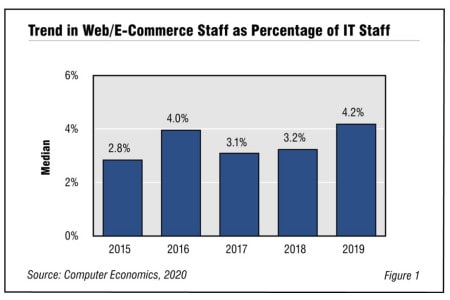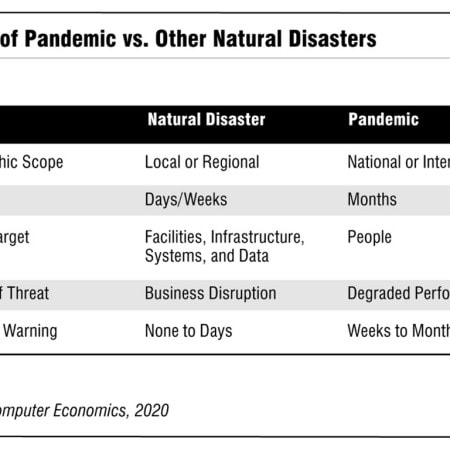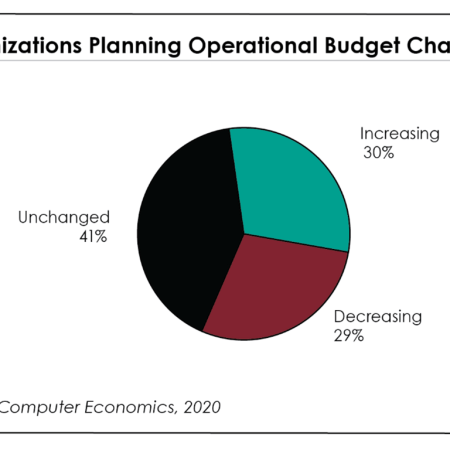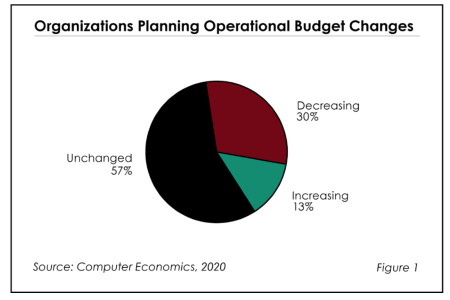-

Key Trends Shaping the Workforce of the Future
The workforce of the future has been debated for years but has never been such a hot topic as today, with the Covid-19 pandemic. It is no longer news that the face of the world and the way we do business has irrevocably changed. Instead of the slow and steady climb toward a borderless, digital society, global economies suddenly found themselves launched onto a new trajectory, forced to adapt to survive. We are watching the workplace and workforce of the future take shape, with changing roles, relationships and demands. There has been a rapid shift toward remote work, innovation and automation, enabled by the ubiquity of technology and the digital economy.
July, 2021
-

Reimagining Indian Enterprises’ Tech Landscape in a Digital-First World: A New Order Out of Chaos
In In the new normal, organizations worldwide are seeking technology to build a digital enterprise, redefine business models, and reimagine workplaces, processes, operations, and supply chains. Our report showcases how Indian enterprises are performing in comparison with global peers in areas such as prioritization and acceleration of digital initiatives, digitization of customer and employee interface, adoption of a hybrid work environment, and readiness for a collaborative human-machine digital workforce. The report also addresses how Indian enterprises are pivoting to new business and delivery models to innovate and generate new revenue streams.
June, 2021
-

Key Budget Trends in Response to COVID-19
Due to the devastating effects of COVID-19 in the first quarter of 2020, the global economy went into a recession. Organizations faced abrupt changes and, for a while, all enterprise investments stood still. However, as the global economy tried to recover, many companies made changes to their operational budgets to respond to the new business landscape. Some changes addressed immediate requirements to keep the business running while others like budgetary changes ensured more long-term viability and growth.
April, 2021
-

Enabling an Ecosystem of Innovation for the Intelligent Enterprise
Avasant, in partnership with Capgemini and Amazon Web Services, hosted a virtual roundtable for a group of senior-level executives to discuss practical ideas and high impact strategies for transforming into an Intelligent Enterprise. What resulted was an powerful knowledge exchange around enterprises’ accelerated shift to Cloud and platform-based services, and the emergence of an AI-First enterprise that leverages data driven insights and hyper personalization to forge digital experiences.
March, 2021
-

Thriving in the New Normal: Enabling Hyper-Scale and Agile Business Through Hybrid Cloud
Avasant, in partnership with HCL Technologies, NetApp, and Cisco, hosted a digital forum that brought together a unique partnership of technology leaders who have pioneered a standardized model that can drive rapid deployment, migration and scaling of hybrid cloud. What resulted was the convergence of thought leadership and practical strategies around enabling hybrid cloud for business agility and sustainable innovation.
March, 2021
-

RCM Outsourcing on the Rise Due to COVID-19 and Changing Reimbursement Models
The pandemic reinforced the need for healthcare organizations to digitalize and automate their customer-facing patient experience processes. Healthcare providers report higher digital engagement and telehealth utilization, as over 50% of patients expect providers to have digital capabilities. Key areas healthcare providers are focused on improving include patient scheduling, secure online auto-payment options, telehealth and remote patient monitoring, and financial counseling with increased price transparency. Further, the shift from fee-for-service reimbursement to value-based care is driving healthcare providers to focus on core operations and enhanced patient experience. This has increased the outsourcing of RCM middle- and back-office functions. COVID-19 and a move to value-based care have incentivized the adoption of digital operations in RCM. These trends are covered in Avasant’s new RCM Business Process Transformation 2021 RadarView™ report.
April, 2021
-

COVID-19 Driving Growth of Digital Operations
The COVID-19 crisis led to severe disruptions in the global socio-economic structure and adversely impacted enterprises. Enterprises were forced to explore all possible avenues to sustain business operations. While cost optimization was one objective, the focus shifted enabling digital operations. Enterprises that had already outsourced could mitigate the COVID-19 impact better than those keeping operations in-house. BPO service providers reacted quickly, leveraged technology, and developed tailored solutions for seamless business operations. This led the enterprises follow the suite driving double-digit growth in BPO engagements in 2020. These trends are covered in Avasant’s new Business Process Transformation Horizons report.
March, 2021
-

Employee Centricity and Customer Experience Takes The Forefront
COVID-19 has brought focus back on collaboration, automation, and security, however this time it centers around employee engagement and customer experience. Owing to the pandemic, there is sudden change in people’s habits and preferences, specifically the way they operate and interact as they embrace work-from-home culture. Progressive enterprises are adopting a “cloud-first” strategy and looking for newer digital ways of working and serving their customers. Zensar, being cognizant of this trend, has already identified and laid out a digital enterprise priority, hinged around enabling experience, business agility, and automation.
October, 2020
-

Covid-19 Pandemic Boosting Demand for Web/E-commerce Personnel
Web/e-commerce support personnel have been increasing as a share of the typical IT staff over the past five years. And now, as a result of the COVID-19 pandemic, this IT staff position is getting a big boost as organizations are having to increase their digital interactions with customers, partners, and suppliers.This Research Byte summarizes the five-year trend in web/e-commerce staffing ratios.
April, 2020
-

Business Continuity under a Pandemic Scenario
Pandemics are fundamentally different from the disasters commonly envisioned in disaster recovery and business continuity plans. The most recent threat of the Wuhan coronavirus highlights the fact that most organizations are not prepared for a pandemic scenario. This updated report outlines the specific ways in which pandemics are different from other types of disasters. It suggests three planning scenarios, and it outlines specific actions that IT risk managers should consider to prepare for them. If adequately prepared, the IT group will be able to continue to support critical business functions, and it can provide solutions to help the organization get through a pandemic.
February, 2020
-

Revisiting the Impact of COVID-19 on IT Organizations in 2020
Our latest survey shows that that a K-shaped recovery of IT spending has begun. Nearly an equal number of companies have increased their IT budgets in response to the pandemic as those that decreased them, with slightly more actually increasing. This report outlines how the pandemic is affecting IT operational budgets, IT capital budgets, IT staff head counts, compensation, outsourcing, budgets for new projects, and the use of the public cloud. It also shows trends in working from home.
October, 2020
-

COVID-19: Enterprise Resilience Is Tested Like Never Before
With the ongoing pandemic many stories emerged of resilience, responsiveness, and innovation, as many of us are forced to live in the future. People were asked to act against their nature and shift from a collaborative workplace environment to isolation at home, further blurring the lines between work and life. This led to a need to strengthen the digital muscle hinged around remote-first working, cloud acceleration, smart IT operations, and automated business operations. Infosys seems to have already laid down the digital rail tracks which helped boost revenue and profit, reflecting resilience and adaptability of its business model in this time of crisis.
October, 2020
-

Coronavirus Impact on IT Budgets Still Coming
Benchmarking IT spending and staffing is a complicated task in the best of economic conditions. Benchmarking in the middle of a global pandemic and recession is even more difficult, but also more important. As we prepare the launch of the 31st edition of our annual IT Spending and Staffing Benchmarks report, this is the challenge.
July, 2020
-

Computer Economics: Revisiting the Impact of COVID-19 on IT Organizations in 2020
Computer Economics: Impact of the Coronavirus Pandemic on IT Budgets in 2020 At the beginning of 2020, IT organizations were poised for another year of strong IT operational budget growth—and then the global coronavirus pandemic struck. IT leaders are changing their priorities for new projects as a result of COVID-19. Based on the results of the 31st annual Computer Economics IT spending survey just completed, Avasant’s digital forum “Computer Economics: Impact of the Coronavirus Pandemic on IT Budgets in 2020” discussed how companies are responding to the crisis.
October, 2020
-

Retail IT Spending Needed for Digital Transformation
The retail sector is going through a major transformation. Brick-and-mortar stalwarts are filing for bankruptcy or disappearing entirely. E-commerce and the digital customer experience are taking an increasing part of the shopping dollar. And all of that was happening before the COVID-19 pandemic forced major restrictions on brick-and-mortar shopping. Traditional retail is in a “change or die” mode, and the transformation of IT is going to decide who survives. This Research Byte is a brief summary of our special report on IT spending trends in the retail sector, which is available for free download.
October, 2020

 Grid View
Grid View List View
List View